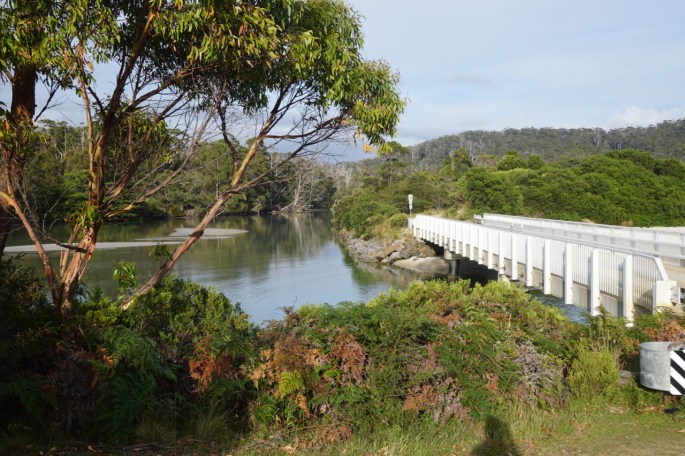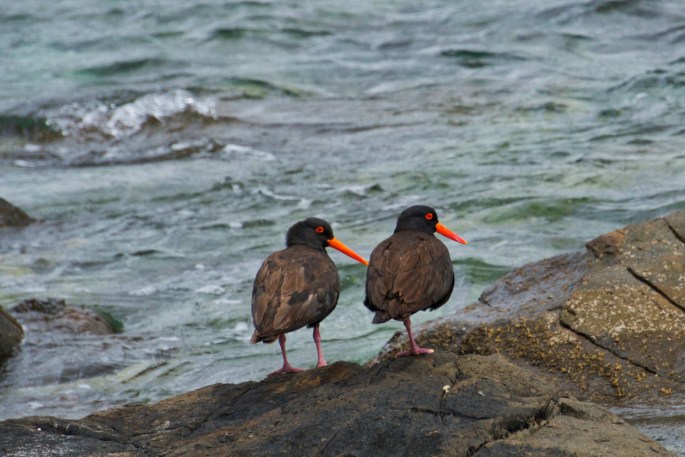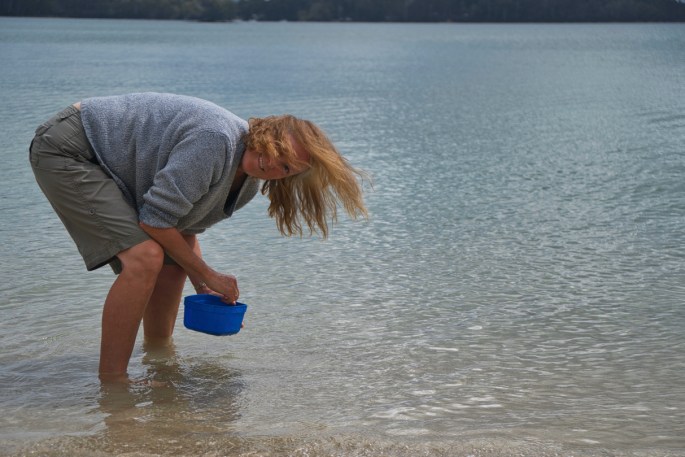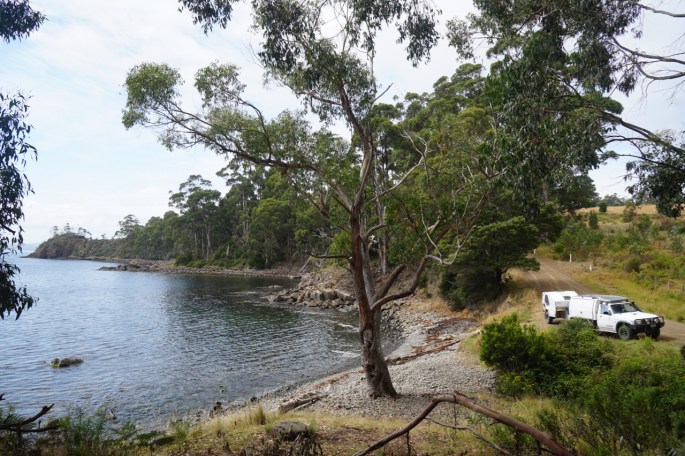After four days enjoying the relaxed camping at Geeveston it was time to move south again. Geeveston whilst just a small town had offered just what we needed. A comfortable grassy site with a few good shade trees just a short walk from the main street where the basics could be bought, a newly commissioned amenities block, fresh water & a dump point. All just at hand. $5 per vehicle per night collected by Charlie who on your first night welcomes you to his town with a little ‘showbag’ containing local information of interest to travellers. A river where we watched a number of Platypus playing in the evenings, & an excellent & helpful information centre/museum, plus a shady spot to sit & enjoy free Telstra internet…. it had it all. Somehow that description fails to convey why we like Geeveston so much. It has something to do with friendliness & community. A community with higher than average volunteer rates & who seem to understand what travelling folk want. For us the existence of The Red Door Larder said much about the community. It is the sort of shop every community should have, but few do. Open 3 days per week it sells local produce, someone bakes a few extra muffins, catches more fish than they need, pick some fruit from their garden, veggies from their vegie patch, make some jam etc etc ….. they take them to the Red Door Larder & are paid for them, & the goods then sold to customers like us for a small mark up. Prices we paid were cheap, we bought ‘real tomatoes’ blueberry muffins, locally collected & dried pepperberries, free range eggs, & fruit (including some apricots brought in by a young lad who had ‘scrumped’ them off his grandma’s tree). You don’t get to leave the shop without a bit of a natter. Stock changes throughout the day as more is brought in so we paid multiple visits.


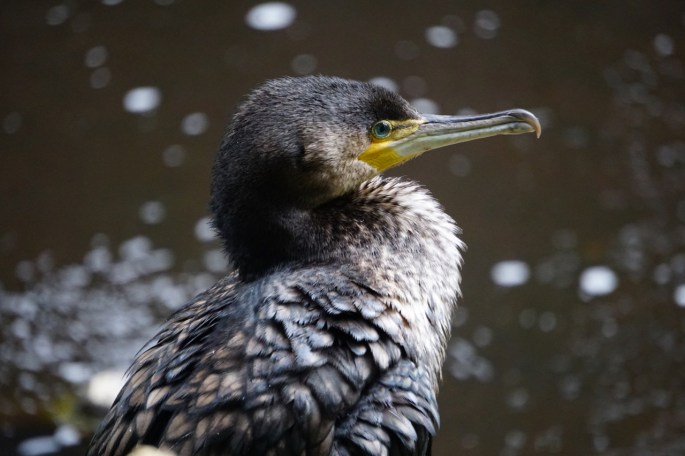

We enjoyed being lazy & relaxing in Geeveston, but also caught up with an old friend again. She, like us, is travelling around Tasmania, as she has done every summer for the past few years. It was her who put us onto the Red Door Larder (as well as several of the better roadside fruit stalls in the area). We did get ourselves into gear once or twice, going out exploring the area in the car & fishing off the nearby Huon Port wharf. All enjoyable but once again the fishing was not very productive. Mainly small Flathead too small to keep. An exploratory drive down past Ida Bay & along the ‘high clearance only’ 4wd track to Southport Bay to see if we wanted to drag the Tvan there resulted in a decision not to do so. We could have taken the Tvan in, very slowly, but the few camp spots by the bay were all too small for us to get into & so we decided to make Cockle Creek our next stop, but first enjoyed a visit to the Wooden Boat Centre at Franklin. A unique place where it is still possible to undertake an apprenticeship in the art of boatbuilding. It’s hard not to be impressed by the artisanship on display.



En route to Cockle Creek we explored bay after bay, found an almost hidden Salmon farm complete with it’s hazchem warnings & stopped to fish off the jetty in the village of Dover. Here I caught a Flathead every few minutes, exciting to start with but after 20 or so undersized fish it became a little tedious. A few other hopefuls were getting the same result – no ‘keepers’ to eat. The salmon farm from a distance, across the bay looked relatively innocuous but close up it was clear that this is factory farming at an industrial level. Large trucks of fish food arrived every few minutes, fish food derived from fish caught elsewhere & ground into meal. The salmon are grown in extensive floating ‘paddocks’ & many Tasmanians are now waking up to the problems these farms cause. Fish farming in itself is a great idea, but big money is involved, & big money wants bigger profits. Consequently we were looking at huge unsustainable enterprises which are poisoning the resources they are using. Controversially companies like Tassal, who promote themselves as clean & green are wanting to expand their operations still further. Another environmental stoush in the vein of past (& ongoing) logging operations. They argue that jobs are provided…. and they are, and folk need to provide for their families, but how many ecosystems in this ‘clean & green’ isle must be destroyed before the place loses it’s special worldwide reputation. We choose not to buy factory farmed Tasmanian salmon, no matter how enticing the package.

South of Dover is the small town of Southport. Arriving at the main jetty we were looking at a grey body of water, smelling a putrid sulphur-like smell reminiscent of outback bore water, but which we think may have been rotting seaweed, and a number of houses & shacks which looked uncared for. It was not an impressive entry into the town which as it turned out became somewhere quite beautiful. After following the beach-side road for a couple of kilometres to the boat ramp it felt like we had stepped into another world. White sandy beaches, aqua blue water & even a lovely little picturesque island in the middle of the bay.

As I write this we are back in Geeveston after 5 glorious nights at Cockle Creek. The place is beautiful. Run by the Parks & Wildlife department who provide toilets & camping spots free of charge for folk to stay at for up to a month at a time in this southerly slice of heaven. This is as far south as it is possible to drive in Tasmania, & I read somewhere that it’s location is closer to the Antarctic than it it is to Cairns in North Queensland. White beaches, crystal clear blue water & another place just so easy to relax & chill out for a while. We did one walk across multiple small bays lined with forest, some rocky, some sandy & some mixed. The walk which took us about 3 hours return was about the limit for my knee which seems to be slowly improving, took us to Fishers Point, where the ruins of an old 1800’s convict built whaling station is hidden in forest . From here the inhabitants kept watch for passing whales & when one was spotted boats were launched & the whale taken with hand held harpoons. It would have been a frantic, dangerous & bloody exercise, followed by what I imagine must have been an equally unpleasant task of rendering the whale blubber to meet the lighting needs of the people of the time. We would have liked to do the longer walk to South Cape, a return walk of 15kms but felt it would be too much too soon for the knee. Fellow campers who made the trek talked of huge ocean waves, higher than tall trees smashing against the base of cliffs. We pottered & fished. Again caught nothing but gratefully accepted a good sized Australian Salmon from a couple of young ladies, the only ones on the beach to catch anything the entire time we were there … and it was their first time fishing.
